
|
Sale 76
Manuscript Sale
| Lot |
Photo |
Description |
Realized |
Lot 487 |
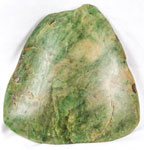 |
Neolithic Celtic Hand Jade Tool. Found at a prehistoric village site on Loire Inferieur, near Nantes, Clausen, France. Size: 10.1 m. Estimated Value $400 - 500
View details and enlarged photo
| Realized
$528 |
Lot 488 |
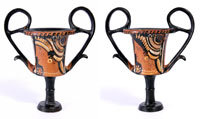 |
Ancient Greek, Apulia Late 4th Century BC Kantharos. Red figure Kantharos with the head of a lady of fashion on both sides. Excellent condition, no chips and intact with some minor repair. Size: Height 7½". Estimated Value $700 - 800
View details and enlarged photo
| Realized
$1,260 |
Lot 489 |
 |
Ancient Greek Stemmed Black-glaze Kylix, ca. 480 BC. Finely incised flower bouquet inside. Intact with some minor repairs. A lovely kylix. Size: Dia: 10½". Estimated Value $500 - 600
View details and enlarged photo
| Realized
$528 |
Lot 490 |
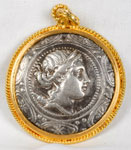 |
Ancient Greek Coin Pendant. Macedon. Under Roman rule. Silver Tetradrachm struck after 168 BC. Diademed head of Artemis right, quiver over her shoulder, at the center of a Macedonian shield. Reverse: Herakles club, monograms; all within oak wreath. Housed in a custom yellow gold bezel which is 18kt or higher. Total weight 26.4 gr. Sold "as is". This may be an electrotype; because of the bezel, it is difficult to tell. Should be bought as jewelry. Estimated Value $250 - 300
View details and enlarged photo
| Realized
$1,107 |
Lot 491 |
 |
Elymais 1st millennium BC Silver Earring. An Elamite votive or royal gift, inscription along base. Heavy penannular earring of crescent shape., top sides beveled and can also be worn as a ring. Very rare for an earring to bear an inscription.Ring size: 7.5. Weight: 8.1 grams. Estimated Value $300 - 400
View details and enlarged photo
| Realized
$221 |
Lot 492 |
 |
Greek Illyrian Classic Bronze Helmet, circa 500-400 BC. The type of helmet worn by the armies of Alexander the Great - the Illyrian's were defeated by Alexander's father Philip II about the time Alexander was born in Pella in 356 BC. When Alexander was just 20 years old he defeated the Illyrian leader Cleitus in 335 BC. His Illyrian forces joined with Alexander during his conquest of the world. An excellent domed helmet with beautiful patina and long cheekpieces with a short flange, two raised ridges running over the crown, the helmet perimeter with an ornate border of decorative punched circles, attachment hook at center back. The incised quidelines were for decorative attachments of horsehair or feathered plumes. Two original pieces professionally reattached on the rear flared rim and a small restored hole nea r the top of the helmet, otherwise, overall excellent condition. An excellent example. Measures 24.7 cm high. Estimated Value $15,000 - 18,000
Acquired in 1988, Switzerland, cf. Antike Helme, by Marcus Egg, Manz 1988, p. 382, no. 5.
View details and enlarged photo
| Realized
$19,680 |
Lot 493 |
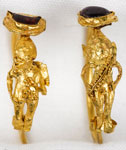 |
Pair of Greek Gold Eros Earrings, ca. 300-200 BC. Fine gold figures of a winged and garlanded Eros with cabochon garnet gem stone setting above each figure. Choice condition. Each diameter size 21 mm. Estimated Value $2,000 - 2,500
The Sir Sidney Nolan Collection, Christie's London, 1993; Ex Hendershott Coll. June 2005, Sale 135, lot 16.
View details and enlarged photo
| Realized
$1,230 |
Lot 494 |
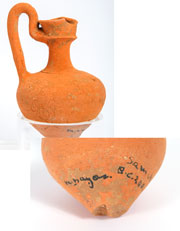 |
Judea. Samaria, circa 200 BC. Terra-Cotta Amphora. From the Moshe Dayan collection, signed in full and dated on the base. Fine orange slip with some incised decoration. Minor chip on the lip. Housed in a custom Lucite case. Height: 5". Estimated Value $500 - 600
View details and enlarged photo
| Realized
$600 |
Lot 495 |
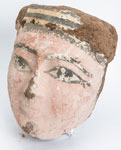 |
Ancient Egyptian Kah Mask, Ptolemaic Period, 332-30 B.C. Life-size wooden (cedar) mask with original polychrome paint over gesso. Size: 9" x 7". In a custom clear plaster display box. Estimated Value $500 - 750
View details and enlarged photo
| Realized
$870 |
Lot 496 |
 |
Luristan, ca. 550-450 BC. Bronze Bird Figure. Complete bronze figure of a fantastic bird with hole at lower neck for suspension. Lower extremities include two front legs, two wings and a platypus-like tail. Height: 2¼". Intact, no restoration with lovely green patination. Includes custom lucite mirrored display box. Estimated Value $400 - 500
View details and enlarged photo
| Realized
$504 |
Lot 497 |
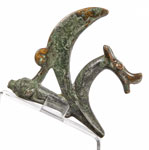 |
Luristan, ca. 600 BC. Silvered Bronze Pin. A mythological winged-bird design. Ending shaft missing, otherwise in excellent preservation with partial green patina. Length: 2"; Height 2 1/8". With custom lucite display box. Estimated Value $350 - 450
View details and enlarged photo
| Realized
$240 |
Lot 498 |
 |
Ancient Babylonian Double Edge Bronze Sword, circa 700-600 BC. The double edge blade with incised vertical lines terminates with a mid-rib grip and domed rib inWell known during the Biblical period of Judean history, Alexander the Great certainly would have recognized this sword in the hands of his Persian adverssaries during the battles against King Dairus. Intact and free from repairs. Fine green and brown patina. Length: 25" . Estimated Value $2,000 - 2,500
Ex Axel Guttmann Collection Germany (purchase thru Gary Hendershott).
View details and enlarged photo
| Realized
$1,415 |
Lot 499 |
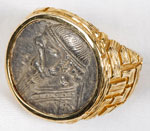 |
Ancient Persian Gentlemen's Gold Ring. Setting is 22 kt yellow gold of layered brickword decoration. Inset is a huge impressive Parthian Empire silver drachm with the head of the Persian king Mithradates II, 128-88 BC. The setting is modern. Ring size: 11.5; Weight: 20.7 grams. An impressive ring! Estimated Value $800 - 900
View details and enlarged photo
| Realized
$900 |
Lot 500 |
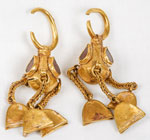 |
Pair of Ancient Parthian Gold Earrings, circa 1s Century AD. A stunning matched pair composed of hollow gold form with convex shaped base, each set with three tear-shaped dark red garnets in gold settings surrounded by granules, a solid gold hoop, the body with three braided gold chains with additional bell-shaped pendants. Superb condition and wearable! Length: 5.1 cm; Weight: 11.9 gr. Estimated Value $2,000 - 2,500
Heidi Vollmoeller collection, Switzerland acquired in 1960; Ex Hendershott Coll. June 2005, Sale 135, lot 14.
View details and enlarged photo
| Realized
$1,353 |
Lot 501 |
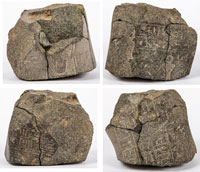 |
Egyptian Granite Block Statue Fragment, ca. Late Dynastic Period. Upper portion of a block statue with incomplete hieroglyphics on 4 sides. The fragment has been cracked and repaired. Diameter 5"; width 4". Estimated Value $1,000 - 1,500
View details and enlarged photo
| Realized
$2,040 |
Lot 502 |
 |
Ancient Egyptian Heart Scarab Necklace. Large green glaze faience Heart Scarab, Late Dynastic Period, circa 1085-525 BC. Beautifully designed into an eminently wearable necklace with coral, ivory and turquoise beads. Length: 24" . Estimated Value $700 - 800
View details and enlarged photo
| Realized
$528 |
Lot 503 |
 |
Ancient Egyptian Heart Scarab Necklace. Large, well defined, green glaze faience Heart Scarab, Late Dynastic Period, circa 1085-525 BC. Showcasing the large ancient Egyptian Heart Scarab are various size agate and ivory beads. Length: 28" A stunning piece! Estimated Value $700 - 800
View details and enlarged photo
| Realized
$750 |
Lot 504 |
 |
Egyptian Miniature Alabaster Amphora. Circa 1st millenium BC. Size: 59 mm. Estimated Value $250 - 300
View details and enlarged photo
| Realized
$168 |
Lot 505 |
 |
Ancient Canaanite Green Jasper Hard Stone Scarab. Middle Bronze Age, 1730-1550 BC. Stylized back and head, simple incised legs with hieroglyphs on base. Size: 17.1 x 22.2 x 8 mm. Estimated Value $250 - 300
View details and enlarged photo
| Realized
$360 |
Lot 506 |
 |
Ancient Egyptian Bronze Eye of Horus, Late Dynastic Period, 1085-380 BC. Inset with polished carved stones flanking the iris. Size: 86 mm x 13 mm. An impressive object of antiquity. Perfect for an ophthalmologist! Estimated Value $700 - 800
View details and enlarged photo
| Unsold |
Lot 507 |
 |
Ancient Egyptian Faience Ring, ca 1450-1250 BC. Open work faience ring of attractive blue-green color. Bezel shaped as an udjat. Intact and without repairs. Dia. 22 mm; Ring size: 6. Estimated Value $350 - 400
View details and enlarged photo
| Realized
$480 |
Lot 508 |
 |
Ancient Egyptian Gaming Piece, circa 3rd Intermediate Period (1000-700 BC). Conical piece in brilliant blue-green glazed faience. Probably a piece for the game of senet, the most popular board game played by the Egyptians (a cross between checkers and backgammon. Size: 12.7 mm. Estimated Value $250 - 300
View details and enlarged photo
| Realized
$312 |
Lot 509 |
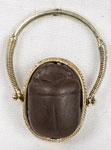 |
Ancient Egyptian Scarab Ring. Late Period. A fine carnelian hard scarab. Mounted into a modern 14 kt yellow gold ring. Choice condition Ring size: 7. Estimated Value $400 - 500
View details and enlarged photo
| Realized
$456 |
Lot 510 |
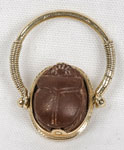 |
Ancient Egyptian Scarab Ring. Late Period. A fine carnelian hard scarab of a male striding forward mounted in a modern 14 kt yellow gold ring. Choice condition. Ring size 4. Estimated Value $300 - 400
View details and enlarged photo
| Realized
$432 |
Lot 511 |
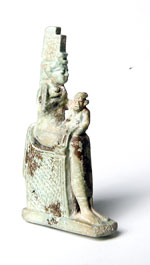 |
Egypt. Faience Amulet of Isis and Horus, 26th Dynasty. Circa 600 B.C. Isis wears the Step Crown, suckling Horus. Beautiful pale green. Height: 60.5 mm. Small professional restoration, practically invisible to the naked eye. Estimated Value $400 - 600
Ancient World Arts, Ltd. New York.
View details and enlarged photo
| Realized
$467 |
Lot 512 |
 |
Lifesize Etruscan Terra Cotta Votive Head, ca. 400-300 BC. An attractive Etruscan aristocratic female wearing a crown polos which is covered by a veil that drapes along the sides and behind her head. She also wears a necklace of many amphora shaped pendants and her hair is dressed into curls and ringlets. An important and eye-applealing Greco-Roman antiquity. Height 16". Estimated Value $7,500-UP
From Hendershott Museum Consultants, Decorative Art & American History, Sale 136, lot 65; Ex an earlier Superior Galleries Auction.
View details and enlarged photo
| Unsold |
Lot 513 |
 |
A Rare East Roman "Gold Crown" from Phoencia circa 100 AD. Roman Province of Syria - large sheet gold crown "Diadem" finely made and complete with both sides. One of the wealthiest provinces in the Roman Empire, Syria became Rome's largest and most prolific trading area providing raw materials including gold for the Roman Empire. Mounted on a clear plastic board. Size: 9½" x 9½". Estimated Value $7,000 - 9,000
From the Axel Guttmann Collection Germany. Acquired in Cologne, 1969. Ex Gary Hendershott Coll., lot 13; Ex Christies, Sale 9832, April 28, 2004, lot 415.
View details and enlarged photo
| Unsold |
Lot 514 |
 |
Roman "Foot" Oil Lamp. Hanging lamp in the form of a sandalled right foot. Chain for hanging on lampstand attached above ankle and below instep. The sandal is of the Greek type, high in back, sloping downward around the ankle bone and tying over the instep. The toes are left bare except for straps. Nozzle attached to big toe; reservoir underneath foot, sole of sandal patterned. Green-patinated bronze. Lid covering filling hole where the foot terminates above the ankle is missing, otherwise intact. Fine workmanship. Provenance: Asia Minor, c. 2nd century A.D. L: 12.5 cm, W (of base): 2.3 cm., H: 6.5 cm., L. of chain: 20 cm. Housed in a custom-made, velvet-lined shadow box.
The following information is taken from the 1976 catalog in which this foot was sold (see Provenance). "Lamps in the form of a right foot or a pair of feet, usually sandalled, were popular throughout the Roman empire during the 1st-2nd centuries A.D. The fact that feet, either singly or in pairs, have a history of representation as both funerary and cult objects indicates that the origin of the form had a significance beyond mere fashion.
The idea of death as a journey into an unknown land is one common to many cultures over a long period of time. Usually a barrier, most often a body of water, separated the worlds of the living and the dead. In ancient Persia the belief prevailed that the dead crossed the river separating the worlds on foot rather than in the traditional boat. Vases in the form of footwear found there in Iron Age tombs seem to indicate a symbolic gesture to make sure the dead had comfortable feet on the trip. The belief passed to Egypt where by the Hellenistic period the foot form was used for sarcophagi and cinerary urns presumably designed so that the deceased could be spared the hardship of having to walk. Apparently the idea existed in Italy as well because a sarcophagus in the form of a sandalled right foot was discovered at Reggio.
During the 1st-2nd centuries A.D. the cult of Serapis which also came to Rome from Egypt produced a group of monuments in the form of gigantic right feet, often sandalled. The god was also a popular subject for lamps, probably because of the identification of Serapis with the sun and the obvious connection of the lamp also with the sun.
A common feature to the feet that appear singly, whether Persian, Egyptian or Roman, is that they are all right feet. It is therefore probably that the idea of the left as being unlucky also came to Rome from the East. This superstition is recorded by Petronius in describing Trimalchio's unforgettable dinner party at which a servant was posted to make sure the guests crossed into the room with the right foot first.
Examining [this lamp] in relation to this background presents some interesting theories. The lamp lacks any orientalizing features that might link it directly with the foot of Serapism making its connection with the god, if in fact such a connection exists, an oblique one. A connection between this lamp form and the funerary monuments is more likely because of the importance of lamps in burial ritual and the idea of crossing into the other world in the proper manner.
[This lamp] was a very expensive one in its day and could easily have belonged to just the sort of people Petronius was writing about. Actually on a lampstand such as Lucretius describes and which was discovered at Pompeii it would have been a perfect re-creation of Petronius' image, and it would have lighted the threshold at the same time that it reminded the crosser which foot to use. The naturalistic representation of this lamp as a foot dressed in a Greek-style sandal limits it to private use of some kind because the normal Roman footgear was boots or shoes, sandals being reserved for wear at home and at dinner parties. It is therefore unlikely that such a lamp would have been placed in any sort of official building.
Most likely this lamp is a tomb find, although its exact provenance is unknown. It may have been brought to the tomb as part of the household effects of its original owner, or it may have been specifically intended to aid him in crosssing the threshold to the other world on the right foot and to light his path as he did so. Separating the domestic and ritual functions of this lamp may not be necessary. One has only to examine the Etruscan funerary monuments connecting the idea of death with that of a banquet to discover the appropriateness of our lamp in both capacities." Estimated Value $5,000-UP
Featured on the cover of Journal of Numismatic Fine Arts, Winter 1976, Lot 61. Sold for $5,000. Catalog for that sale is included with this lot.
View details and enlarged photo
| Realized
$2,640 |
Lot 515 |
 |
Roman Pottery Pilgrim Flask, ca. 2nd-3rd Century AD. Terra cotta Pilgrim Flask depicting Gladiators in combat during the era of Christian persecution. Moulded on each side of the circular body a scene depicting Retiarius and Secutor Gladiators, one with the Victor's palm branch between them and a trident below, on the reverse they are transposed. Excellent condition. Measures: 21.3 cm. tall. Estimated Value $2,000 - 2,500
From the Axel Guttmann Collection, Cologne, Germany 1987.
View details and enlarged photo
| Realized
$1,320 |
Lot 516 |
 |
Roman Limestone, ca. 3rd-5th Century, Christian Chi-Rho Oil Lamp Mold. A very rare and early Roman Period Christian lamp mold with the earliest form of a Christian cross, the "Chi-Rho" being the first two letters X and P of the Greek word for "Christ."
The Roman Emperor Constantine I (also called "The Great") became the first Christian leader when he had a vision "that under this Chi-Rho" sign he would conquer his adversaries, which he ordered painted on the shields and flags of his armies before the battle at the Milvian Bridge. Excellent condition. Size: Length 21.6 . Estimated Value $2,000 - 2,500
From the Axel Gutmann Collection, Cologne, Germany 1987. Purchased thru Gary Hendershott.
View details and enlarged photo
| Unsold |
Lot 517 |
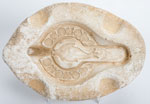 |
Roman Limestone, ca. 3rd-5th Century, Christian Oil Lamp Mold. A very rare and early Roman - Christian oil lamp mould depicting the symbol of St. Peter. The earliest Christian apostlic secret symbol of St. Peter, recalling when Jesus first met Peter at the sea of Galilee and made him a "fisher of men." Excellent condition. Size: Length 21.6 cm. Estimated Value $2,000 - 2,500
View details and enlarged photo
| Unsold |
Lot 518 |
 |
Roman Bronze Fibula, ca. AD 2nd - 3rd Century. Back with some original gilding and the pin intact. Length 61 mm. Estimated Value $300 - 350
View details and enlarged photo
| Realized
$252 |
Lot 519 |
 |
Ancient Roman 1st-2nd Century Gold Hair or Clothing Pin. Amethyst footed discold bead in pin mount, knotted. 74 mm x 14 mm. Choice condition. Estimated Value $500 - 600
View details and enlarged photo
| Realized
$394 |
Lot 520 |
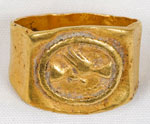 |
Ancient Roman Gold Betrothal Ring, circa 1st Century. Oval discus depicts clasping hands of wedding ceremony. Excellent wearable condition and quite rare. Size: Dia. 22.7 mm. Ring size: 4. Weight: 10.7 grams. Estimated Value $1,500 - 2,000
Ex Gorny Sale, December 2003, lot 145.
View details and enlarged photo
| Realized
$930 |
Lot 521 |
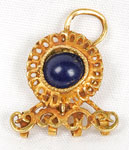 |
Ancient Roman Gold Earring, circa 2nd-3rd Century. Roman triangular earring with inset dark blue gemstone. Superb quality and can be worn as a single earring or a pendant. Dia. 18 mm; Weight: 1.8 gram . Estimated Value $400 - 500
Ex Gerhard Hirsch, Munich, 5-25-91.
View details and enlarged photo
| Realized
$264 |
Lot 522 |
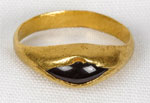 |
Ancient Roman Gold Ring, circa 2nd Century. Eye shaped dark red garnet center set. Size: 17.32 dia. Ring size 2. Wearable condition. Estimated Value $500 - 600
View details and enlarged photo
| Realized
$308 |
Lot 523 |
 |
Pair of Late Roman or Early Byzantine Period Gold Earrings, ca. AD 5th-8th Century. Each composed of a frontal dome or shield with circular and granual decoration with a ridged collar and terminating with three pendant spheres resembeling a jeweled crown. The gold hoop is wound with fine gold wire. Choice condition. Length 51 mm, diameter 23 mm. Weight: 14.6 g. Estimated Value $1,500 - 2,000
Accompanied by a Christie's April 28, 2004, Sale 9832, lot 409 tag; Ex Gary Hendershott Collection.
View details and enlarged photo
| Realized
$2,040 |
Lot 524 |
 |
Roman Bronze Figural Finial Terminal, c. 2nd Century AD. Cast finial with a hollow, cylindrical barrel terminating in a caricature of an African, with staring eyes, a heavy brow ridge, nappy hair, thick lips, and a deeply cleft chin. He wears a necklace with a lunate pendant. The finial has four loops in two opposed pairs, one with a thick bronze ring still attached. Height: 5.5" (14 cm.). Fine dark green patina with some light ear adhering. A remarkable example of popular culture in the Roman period. Estimated Value $1,000 - 1,500
View details and enlarged photo
| Realized
$690 |
Lot 525 |
 |
Roman Bronze Togatus Figure, c. 2nd-4th Century AD. Of solid orichalcum, the individual is perhaps an orator, with right hand raised in a gesture of discourse, his left hand clutching the umbo of his toga. The folds of his garment are elaborately rendered, while his feet, hands and face are comparatively crude. His hairstyle suggests a late imperial date, but his toga is of the early Imperial type, perhaps in imitation of earlier styles. There are three drilled holes, one near each shoulder and another between the feet. Height: 5¼" (13.5 cm). "Tiber" brown patina in front, dark brown patina in back. Estimated Value $1,000 - 1,500
Published in Freeman & Sear MBS 12, Oct. 28, 2005, lot 680.
View details and enlarged photo
| Realized
$769 |
Lot 526 |
 |
Roman Gold Earrings, c. 3rd Century AD. A matched set with minor individual variations. Each is comprised of a figure of Cupid on a matrix of white material, perhaps bone or glass paste, inset in a twisted gold wire frame. In the rear of each is attached a gold wire for insertion into the earlobe. Cupid leans (to the left in one earring and right in the other) against an upturned torch and is in a posture of mourning; legs crossed and arms folded, chin resting on palm. The subject's posture in combination with the upturned torch may mark these earrings as funerary in purpose. Dimensions approximately: 1.4 cm x 1.3 cm. Choice condition, each with a faint hairline crack that was probably present since antiquity. Estimated Value $1,500 - 2,000
Published in Freeman & Sear's MBS 12, Oct. 28, 2005, lot 684.
View details and enlarged photo
| Unsold |
Lot 527 |
 |
Gold Charm, stamped in Guilloche Pattern and Crystalline Gold Nugget. Probably Middle Ages period. Weight 0.6 gr. Together with: Crystaline Gold from Alaska or Yukon. Weight: 3.1 gr. Lot of 2 items. Estimated Value $300 - 400
From Joel L. Malter & Co. Auction XXVIII, Dec. 8, 1984.
View details and enlarged photo
| Realized
$180 |
Lot 528 |
 |
Antique Silver Coin Pendants. Consists of 3 different silver coins made into pendants as follows: 1650 Germany, Nurnberg Silver Klippe. Half Taler Size (38 mm.) issued to commemorate the Treaty of Westphalia; 1763 Germany, Wurzburg 20 Kreuzer; 1749 Italy, Lucca, Scudo. St. Martin on horseback sharing his coat with a begger. Each with a suspension loop. Estimated Value $500 - 750
View details and enlarged photo
| Realized
$312 |
Lot 529 |
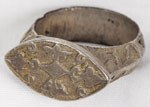 |
Islamic 9th-12th Century Silver Ring. Size 11. 14.2 grams. Wearable condition. Estimated Value $250 - 300
View details and enlarged photo
| Realized
$144 |
Lot 530 |
 |
Antique Asian Gold Lion Earrings. Probably Chinese orgin. Large hoop earrings of 20 kt yellow gold stylized lions. Beautifully decorated and well made. Superb condition. Weight 12.2 gr. Each 28 mm. Estimated Value $700 - 900
View details and enlarged photo
| Unsold |
Lot 531 |
 |
China Ming Porcelain Group. Consists of: Double Gourd Vase (2 pieces) and Minature Vase (2 pieces) matching design. Part of the Ming Porcellain cargo of a Chinese tradidng vessel which sank circa 1640. Discovered and salvaged by Captain Michael Hatcher in 1983 outside Malaysia in the South China Sea. All in perfect condition. Each 66 mm. Estimated Value $200 - 300
From Christies, Amsterdam, 1984/85. Each with a COA from Harrods, Knightsbridge.
View details and enlarged photo
| Realized
$312 |
Lot 532 |
 |
"Moko-Jumbe" Caribbean Wooden Tribal Art, circa 18th-19th century. Height 35", width 7". Movable jaw displaying teeth. Used in Carnivals and street dancing celebrations in many of the Caribbean islands. Variations of this can still be seen today. Very unusual and very visual. Fine working condition. Estimated Value $300 - 400
View details and enlarged photo
| Realized
$180 |
|
|